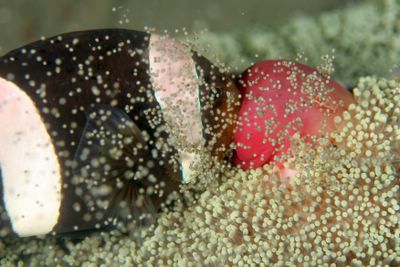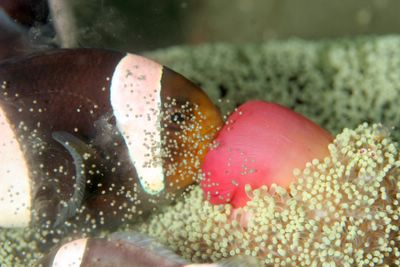
Banded Pipefish. Try saying this scientific name three times ...
Dunckerocampus dactyliophorus.
Most of the photos posted to this page were taken with a Canon 20D in an Ikelike housing with TTL connection to an Ikelite DS-125 and an Inon 2000 substrobe. I also use a Sony Cybershot P150 in a Sony housing attached to a Sea & Sea YS-25 via fiberoptic cable.

 Tuesday's question was correctly answered by two overachievers, Nick Hobgood (who answered in about 16 seconds after the photo was posted) and Dave McKee (all the way from Jerusalem). The photo is of eggs inside the fused pelvic fins of a Robust Ghost Pipefish, Solenostomus cyanopterus.
Tuesday's question was correctly answered by two overachievers, Nick Hobgood (who answered in about 16 seconds after the photo was posted) and Dave McKee (all the way from Jerusalem). The photo is of eggs inside the fused pelvic fins of a Robust Ghost Pipefish, Solenostomus cyanopterus.

 Although the ctenophore was nearly the same size as the opistobranch (3-4 cm), the latter had no trouble engulfing the former. The event happened rather quickly, with no hesitation whatsoever, perhaps 8-10 seconds. In the third photo, a branched feeding tentacle can be seen coming off the right side of the ctenophore, even while most of it's body is inside the opistobranch.
Although the ctenophore was nearly the same size as the opistobranch (3-4 cm), the latter had no trouble engulfing the former. The event happened rather quickly, with no hesitation whatsoever, perhaps 8-10 seconds. In the third photo, a branched feeding tentacle can be seen coming off the right side of the ctenophore, even while most of it's body is inside the opistobranch.
This is Dr. Rudman's response.
 We don't know much about the biology of benthic ctenophores, in fact when I do a web search I usually end up on the Sea Slug Forum, where we have photos of a number of species, and some spectacular shots of animals with their feeding tentacles greatly expanded. Aglajids are unusual opisthobranchs because most have lost their radular teeth and so have evolved ways of feeding which involve either sucking in their prey whole - like eating a piece of spaghetti - in the case of the worm-eating Melanochlamys, or engulfing it by everting a large cylindrical buccal bulb - in the case of Philinopsis - which feeds on cephalaspidean bubble shells. Your animal has a foregut then, which is quite capable of engulfing a large prey item such as a benthic ctenophore.
We don't know much about the biology of benthic ctenophores, in fact when I do a web search I usually end up on the Sea Slug Forum, where we have photos of a number of species, and some spectacular shots of animals with their feeding tentacles greatly expanded. Aglajids are unusual opisthobranchs because most have lost their radular teeth and so have evolved ways of feeding which involve either sucking in their prey whole - like eating a piece of spaghetti - in the case of the worm-eating Melanochlamys, or engulfing it by everting a large cylindrical buccal bulb - in the case of Philinopsis - which feeds on cephalaspidean bubble shells. Your animal has a foregut then, which is quite capable of engulfing a large prey item such as a benthic ctenophore.


